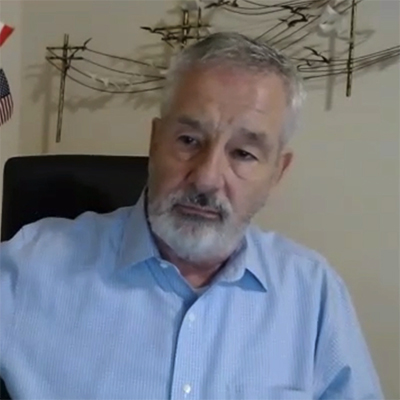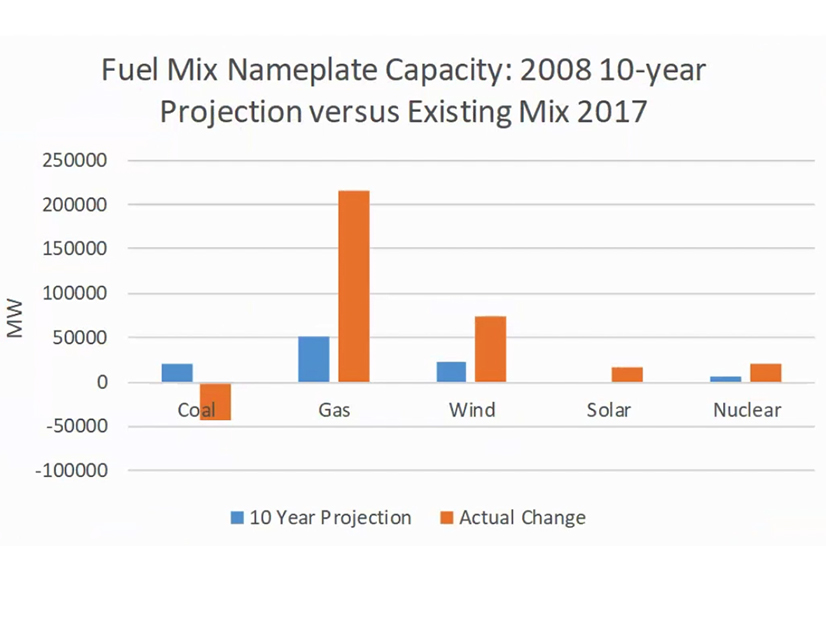Speakers at the North American Generator Forum’s (NAGF) Virtual Compliance Conference this week repeatedly urged grid planners to take seriously the challenges of the changing resource mix and other threats to the reliability and security of the grid.

Citing the 2021 ERO Reliability Risk Priorities Report published in August, DeFontes emphasized that grid transformation remains one of the most pressing risks facing the ERO Enterprise. (See Grid Transformation, Cybersecurity Lead 2021 ERO Risk Report.) He warned utilities that they may not be taking the challenges of the transition to renewable resources seriously enough.
Two recent reports lent weight to DeFontes’ concerns. The first was NERC and FERC’s joint inquiry into February’s winter storm that led to unprecedented outages in the Midwest and left hundreds dead in Texas (AD21-28). The final report has not yet been released, but preliminary findings and recommendations were presented at the commission’s open meeting last month. (See FERC, NERC Share Findings on February Winter Storm.)
The second report was NERC and ERCOT’s review of an incident earlier this year in which multiple solar and wind facilities near Odessa, Texas, suffered voltage reductions. (See NERC-ERCOT Report Reviews Texas Solar Issues.) In both incidents, investigators found that entities had not implemented recommendations in NERC’s nonbinding reliability guidelines despite widespread knowledge of their existence and the reasons for them.
“As we learned in the February cold-weather report, there can be dire consequences when guidelines are not followed. I am concerned that we’re seeing a similar trend when I look at the Odessa disturbance report,” DeFontes said. “We see the industry is well aware of the guidelines; they have considered them and adopted some parts of them; but they are not widely and comprehensively being followed, which has left us with potential reliability gaps.”
Noting that FERC Chairman Richard Glick and NERC CEO Jim Robb have promised that the winter storm report “will not sit on the shelf,” DeFontes urged utilities to study the Odessa disturbance report and make a real effort to apply its lessons. He promised that if nonbinding guidelines prove to be insufficient, NERC will “move forward to improve [mandatory] standards.”
Gugel, Lauby Emphasize Changing Grid Conditions
Howard Gugel, NERC’s vice president of engineering and standards, continued the discussion of the changing grid in his presentation. Comparing predictions NERC made in 2008 of fuel mix changes over the next 10 years versus the actual conditions in 2017, Gugel observed that natural gas, wind, solar and nuclear all increased more than expected — gas and wind grew more than four- and threefold, respectively — while coal’s presence in the BPS actually declined, rather than rising as NERC had anticipated.
The growing presence of weather-dependent resources such as wind and solar — along with behind-the-meter resources like rooftop solar, home battery storage systems and grid-connected electric vehicles — poses a problem for system planners, who will “have to become very creative in understanding [the] differences” between these generators and traditional resources.
“Our system was not designed or planned with that in mind, but that reality is coming,” Gugel said. “The question is, how do you adapt for that? How do you become resilient?”
Gugel identified several problems that planners are going to have to solve, including a lack of transparency into current load and status of behind-the-meter resources; inability to quickly ramp up generation among wind and solar resources in the event of an emergency; voltage regulation; and underfrequency load shedding. All of these will require a level of communication that prior generations never anticipated.

NERC Chief Engineer Mark Lauby concurred with Gugel’s warning about the assumptions underlying traditional BPS planning, saying that “that world is slowly disappearing” and that establishing essential reliability services is becoming much more difficult in a world of distributed, smaller, asynchronous generation resources that require much more automation to manage remotely and programming to “ride through minor system disturbances so as not to make them worse.”
The increasing reliance on electronic grid management systems also means that the BPS must be hardened against cybersecurity threats, Lauby observed. Noting recent cybersecurity events like the SolarWinds and Microsoft Exchange Server attacks, he observed that hackers “are not dumb; they are persistent,” having learned how to target a wide range of industries.
“So far, fortunately, we haven’t really seen a breach from [information technology to operational technology], though we have had vulnerabilities we’ve identified and are working to address them,” Lauby said. “But as we start digitizing more … we’re going to have to keep in mind that we design a system that’s robust against those kinds of attacks … so that we’re not as much of a target.”
SERC Shares Self-report Tips
The meeting also featured presentations from other stakeholders, including Janice Carney, senior compliance engineer at SERC Reliability. Carney discussed the importance of self-reporting potential violations of NERC reliability standards, observing that bringing potential compliance issues to a regional entity’s attention voluntarily is “a much better position for an entity to be in compared with a noncompliance found during an audit.”
Information needed in self-reports includes the date of discovery; start and end dates of the noncompliance, with a basis for each; a description of how the infringement was identified; the number of people, devices or systems involved in the noncompliance; the cause of the violation; and prior instances of noncompliance with the same standard.
Carney also emphasized the importance of writing style in self-reports, urging utilities to be as clear as possible by using active voice rather than passive and defining all acronyms on first usage.
Cold Weather Plans Coming Soon
Finally, Venona Greaff, manager of compliance at Occidental Energy Ventures, updated attendees on the new reliability standard EOP-011-2 (Emergency preparedness and operations), approved by FERC in August, and its requirement that generator owners implement plans to protect their units from freezing. (See FERC Approves Cold Weather Standards.)
“As generators, when we think about these standards and how they fast-tracked them after the February [winter storms], it seems like it’s a steam engine barreling down on us at a great pace,” said Greaff, who served on the standard drafting team for EOP-011-2 and the other cold-weather standards.
“But in reality, this has been coming for a long time,” she continued, noting previous cold-weather events that occurred in 2011, 2013 and 2018 — the last of which was the impetus for the cold-weather standards project. (See FERC Orders Cold Weather Reliability Standard.)
While the new standard will not take effect until April 2023, Greaff’s presentation was aimed at providing utilities a basis for starting to develop their plans, including basic attributes such as a purpose statement explaining what the procedure is meant to do and the applicable entity or facility; the personnel who will be responsible for specific activities, as well as for oversight of the entire plan; and critical components and instrumentation that need priority protection.
“One thing I want to remind you [members] of the NAGF is, collaboration and assistance is always an option,” Greaff said. “We currently have a cold-weather preparedness group [that] has 82 members. … I think that we have a lot that we can share with each other, and we can learn from each other in this working group. So I’d encourage you to think about joining the working group. It doesn’t mean that you have to take a lead role; it just puts you in that small group and allows you to be a part of the conversation.”



